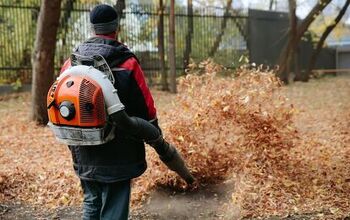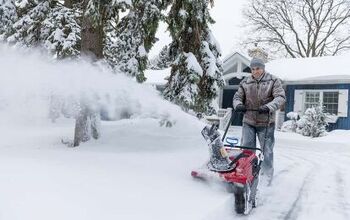Echo Leaf Blower Won't Start? (Possible Causes & Fixes)

When leaves overtake the yard, you want your Echo leaf blower to work correctly. Most people use it to blow the leaves instead of raking them. Others use it for blowing off the driveways and carports after cutting the grass.
There are multiple reasons to use a leaf blower, but there is a problem when it does not start. We will go through the common issues that cause this problem and advise on the solutions. So, what causes starting problems when the Echo leaf blower does not work when you need it the most?
These are the most common reasons a leaf blower will not start:
- Bad spark plugs
- Carburetor problems
- Bad fuel
- Faulty recoil starter
- Spark arrestor
- Fuel filter
- Air filter
- Ignition coil
These items go bad from wear and tear over time. Going through a checklist, you will find they need replacing or simply maintenance.
Do You Need Lawn and Tree Maintenace Pros?
Get free, zero-commitment quotes from pro contractors near you.

Creating a Checklist for Troubleshooting
When you find you are cranking continuously to start the Echo leaf blower to no avail, make a checklist. Start with the most common problems first and go down the list. This list will help save time and money.
All of these problems you can check and fix yourself. Everything is relatively simple and easy to get to with the right tools. If for some reason, the blower will not start after troubleshooting, professional assistance is needed.
It will take a two-cycle certified mechanic to go through the electrical system. If everything has been checked out negative, all that is left is the electrical system and the motor itself. The wise thing to do is not mess with the electrical system yourself, especially if the blower is under warranty.
Step 1: Check the Spark Plugs
About 70 percent of the time, the problem will start and end with the spark plug. Take out the spark plug and inspect it thoroughly. It takes a 5/8″ deep socket and a ratchet to remove and replace the spark plug.
Look for wear and tear around the porcelain insulator. If it is cracked, burned, or damaged in any way, it is a carbon buildup sign. You can also use a spark plug tester to make sure there is a spark.
If the spark plug has any of these issues, replace it with a new one. They are not that expensive and sell between $3 and $4 per plug. You may want to get an extra one for later, just in case.
Step 2: Check the Carburetor and All the Parts
There are multiple things to inspect when it comes to the carburetor because of the many different parts. If the blower sat without running for an extended period, it is most likely clogged from old fuel. When the fuel sits, it leaves a thick, sticky substance that clogs up the parts.
It will take carburetor cleaner spray to clean out the parts and fuel lines. Once it is clean, check the primer bulb on the carburetor for cracks or holes. If air mixes with the fuel, the blower will not start.
Should the parts need to be replaced, a new carburetor cost is between $50 and $60. To rebuild the carburetor with the kit cost between $10 and $15. If the primer bulb needs replacement, it cost between $2 and $3.
Step 3: Check to See if the Fuel is Still Good
This step goes in line with checking the carburetor. If the carburetor’s fuel is bad, then the gas mixture you are using needs to be discarded. It would not be wise to use the same gas mixture if it has sat too long over time.
If the fuel needs to be discarded, be sure to remove it with the environment in mind. Never dump fuel on the ground or in a ditch. Discard it the same way you would rid of old used oil and clean out the gas can.
Step 4: Check the Recoil Starter
There can be multiple issues with the recoil starter. The rope can get jammed inside the recoil or not retract when pulled. For a blower, it can be to purchase a new recoil starter than trying to repair it.
The parts to a recoil starter in a blower may take a long time to locate. Some may be more expensive than replacing it. The cost for a recoil starter is between $40 and $50.
Step 5: See if the Spark Arrestor is Clogged
The spark arrestor keeps the engine from shooting sparks. It is a small screen that can get clogged with debris. There are two options, remove and clean with a wire brush or replace it with a new one.
If the spark arrestor is clogged, it will prevent the blower from starting. It is not expensive or hard to clean. The screen runs between $4 and $5 to replace brand new.
Step 6: The Fuel Filter May Be Clogged
If the fuel filter is clogged, you will find yourself cranking and flooding the engine. It may start, but the horsepower will drop dramatically. One prominent sign the fuel filter is clogged is pressing on the throttle and the engine stalls.
Some of the causes of a clogged fuel filter may be the gas sat in the blower for too long. Others may be forgetting to change it regularly. It is not too pricey, between $9 and $10.
Step 7: The Air Filter May Be Dirty
If you are using the blower in highly dusty places or cleaning out a dryer vent, check the air filter. It is recommended to replace annually, but the air filter is dirtier if a lot of dirt is blown.
If the filter is clogged, more fuel than air will get in the engine. When this happens, the motor cannot breathe, causing the engine to flood. Any time the engine floods, it will not start.
The cost is between $3 to $13 to replace. It depends on the type of air filter required for the blower. There are three different kinds.
Step 8: Checking a Defective Ignition Coil
When the ignition coil goes bad, you should check the spark plug first. This part is costly, and you only want to change it if it goes out. The ignition coil works with the spark plug, sending voltage to the engine while it is running.
If the coil goes bad, the motor will not start. You can test it with an ignition coil tester. Replacing it is the only option if it fails, and the cost is around $85.
How to Prevent Hard to Start Issues with Your Echo Leaf Blower
Everything machine we own needs maintenance. Good maintenance practices will lessen the chances of starting issues. These are tips to help guide you in keeping your blower in tip-top shape.
- Always keep the adequate ratio of gas to two-cycle oil mixture.
- There are some fuel stabilizers you can add to save the fuel from gumming up. Be sure to follow the instructions closely.
- It is a good safety practice to clean the air filter after every fuel-up.
- If you know you will store the blower away for longer than three days, drain the fuel. Once the fuel is depleted, run the blower until all fuel is gone and the motor stops running. This will dry out the carburetor and prevent the fuel from caking up inside the components.
- The better the gas and oil brand mixtures you use, the better your blower will operate. Use only the best.
- Clean all of your yard equipment after each use, not just the blower, when storing away.
A little caring eliminates about 80 percent of problems with starting in maintenance and TLC. There is no 100 percent guarantee for going a season without problems. Doing your part in common sense storage will save you time, headaches, and even money.
Do You Need Lawn and Tree Maintenace Pros?
Get free, zero-commitment quotes from pro contractors near you.

Related Questions
How long does an Echo leaf blower last?
If the proper maintenance is used regularly, an Echo leaf blower can last for over a decade. Keep in mind, a machine can last for many years, or it can break tomorrow. There is no set timeframe.
Is a battery-powered leaf blower better than a gas-powered one?
It depends on the person’s preference and how big of a job they plan on doing with the leaf blower. A rechargeable battery can last up to 30 minutes. A gas-powered leaf blower can last a few hours on one tank of mixed fuel.If the job is short-lived, a battery-powered blower is sufficient. Keep in mind; it takes less time to refill the tank with fuel than it does to recharge a battery. You can do more with a gas-powered leaf blower.
How do I know if the problem is electrical or if there is something wrong with the motor?
Sometimes a wire can get cut that you can spot right away. If the motor is frozen, you will not be able to pull the starting rope.

We are a team of passionate homeowners, home improvement pros, and DIY enthusiasts who enjoy sharing home improvement, housekeeping, decorating, and more with other homeowners! Whether you're looking for a step-by-step guide on fixing an appliance or the cost of installing a fence, we've here to help.
More by Upgraded Home Team



























